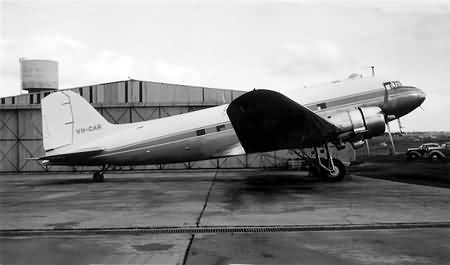02/28/2011. Remarks by Jack McKillop: "This Douglas Model DC-3A-456 was ordered by the USAAF as a C-47A-20-DK, s/n 42-93010 and delivered on March 28, 1944. The aircraft was transferred to the RAAF under Lend Lease as a Dakota Mk.III, s/n A65-46, radio call sign "VHCIC". In May 1944, it was issued to No. 38 Squadron at RAAF Base Richmond, New South Wales and reassigned to No. 36 Squadron at RAAF Base Garbutt, Queensland in December 1944.
This Dakota was retained in the postwar RAAF until transferred to the Australian Department of Civil Aviation on October 26, 1948 and registered VH-JVF on November 17, 1949. It was reregistered VH-CAR on July 14, 1950. This aircraft was used to calibrate ILS (instrument landing system) and DME (distance-measuring equipment) systems.
It was sold to Qantas Empire Airways of Sydney, New South Wales in December 1960, reregistered VH-EDC on June 7, 1961 and leased to Fiji Airways of Suva from April 12, 1965 to June 27, 1966. Sold to Queensland Pacific Airways of Brisbane, Queensland on November 15, 1971, it was again sold to Bush Pilots Airways of Cairns, Queensland on June 17, 1972. It was leased to Connair of Alice Springs, Northern Territory for four months in 1973 to supplement de Havilland Herons on scheduled flights. BPA (NG) bought the aircraft on August 8, 1973 and sold it to Air Queensland, the former Bush Pilots Airways, of Cairns, Queensland on January 8, 1982.
The next owner was DC-3 Queensland Pty. Ltd. of Freshwater, Queensland which bought it on December 12, 1987 and leased it to Air North Queensland of Alice Springs, Northern Territory on June 17, 1988. On July 30, 1992, it was sold to South Pacific Airmotive Pty. Ltd. and at 09:10 hours on April 24, 1994, the aircraft crashed into Botany Bay, Sydney, New South Wales.
The aircraft was en route from Kingsford Smith International Airport in Sydney to Lord Howe Island Airport, New South Wales. There were no fatalities to the 25 people aboard. The aircraft had been chartered to convey college students and their band equipment from Sydney to Norfolk Island Airport, located about 907 mls (1,460 km) east of Brisbane, Queensland to participate in Anzac Day celebrations on the island. The aircraft was to proceed from Sydney Airport to Norfolk Island, with an intermediate landing at Lord Howe Island Airport located about 556 mls (895 km) west-southwest of Norfolk Island to refuel. The flight was to be conducted in accordance with IFR procedures.
The aircraft, which was carrying 21 passengers, was crewed by two pilots, a supernumerary pilot and a flight attendant. Preparations for departure were completed shortly before 09:00 hours and it was cleared for take off at 09:07:53. All engine indications were normal during the take off roll and the aircraft was flown off the runway at 93 mph (150 kmh). During the initial climb, at approximately 200 ft (61 m), with flaps up and the landing gear retracting, the crew heard a series of popping sounds above the engine noise. Almost immediately, the aircraft began to yaw left and at 09:09:04 the pilot in command advised the Tower that the aircraft had a problem.
The co-pilot determined that the left engine was malfunctioning. The aircraft speed at this time had increased to at least 115 mph (185 kmh). The pilot in command, having verified that the left engine was malfunctioning, closed the left throttle and initiated propeller feathering action. During this period, full power was maintained on the right engine. However, the airspeed began to decay. The co-pilot reported that he had attempted to maintain 93 mph (150 kmh) but was unable to do so. The aircraft diverged to the left of the runway center line. Almost full right aileron had been used to control the aircraft. The copilot reported that he had full right rudder or near full right rudder applied.
When he first became aware of the engine malfunction, the pilot in command assessed that, although a landing back on the runway may have been possible, the aircraft was capable of climbing safely on one engine. However, when he determined that the aircraft was not climbing, and that the airspeed had reduced below 93 mph (150 kmh), the pilot in command took control, and at 09:09:38 advised the Tower that he was ditching the aircraft. He maneuver the aircraft as close as possible to the southern end of the partially constructed runway 16L. The aircraft was ditched approximately 46 seconds after the pilot in command first advised the Tower of the problem. The four crew and 21 passengers successfully evacuated the aircraft before it sank. They were taken on board pleasure craft and transferred to shore. The aircraft had 40,195 hours on the airframe.
The investigation found that the circumstances of the accident were consistent with the left engine having suffered a substantial power loss when an inlet valve stuck in the open position. The inability of the co-pilot to obtain optimum asymmetric performance from the aircraft was the culminating factor in a combination of local and organizational factors that led to this accident. Contributing factors included the overweight condition of the aircraft, an engine overhaul or maintenance error, non-adherence to operating procedures and lack of skill of the handling pilot.
Organizational factors relating to the company included: 1) inadequate communications between South Pacific Airmotive who owned and operated the
DC-3 and were based at Camden, New South Wales and the AOC holder, Groupair, who were based at Moorabbin, Victoria; 2) inadequate maintenance management; 3) poor operational procedures; and 4) inadequate training.
Organizational factors relating to the regulator included: 1) inadequate communications between Civil Aviation Authority offices, and between the Civil Aviation Authority and Groupair/South Pacific Airmotive; 2) poor operational and airworthiness control procedures; 3) inadequate control and monitoring of South Pacific Airmotive; 4) inadequate regulation; and 5) poor training of staff.
The aircraft was raised and taken to Camden Airport, Camden, New South Wales where it was used for spare parts."
